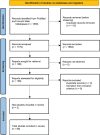Characteristics of cranial vault lymphoma from a systematic review of the literature
- PMID: 35855149
- PMCID: PMC9282819
- DOI: 10.25259/SNI_28_2022
Characteristics of cranial vault lymphoma from a systematic review of the literature
Abstract
Background: Cranial vault lymphomas are rare and their clinical features are often similar to those of cranial vault meningiomas. The objective of this review was to identify the features helpful for differentiating lymphomas of the cranial vault, from meningiomas which were the most common diagnosis before the definitive pathological diagnosis.
Methods: The inclusion criterion was a histologically proven malignant lymphoma initially appearing in the calvarium. We conducted a literature search of the electronic PubMed and Ichushi-Web databases up to June 1, 2020. Cranial vault lymphoma that was diagnosed after an original diagnosis of lymphoma in a nodal or soft-tissue site was excluded from the study. Descriptive analyses were used to present the patient characteristics.
Results: A total of 111 patients were found in 98 eligible articles. Almost all studies were case reports. The most common symptom was a growing subcutaneous scalp mass (84%) present for a mean duration of 5.9 months before the patient presented for treatment in analyzable cases; this fast growth may distinguish lymphomas from meningiomas. The tumor vascularization was often inconspicuous or poor, unlike well-vascularized meningiomas. A disproportionately small amount of skull destruction compared with the soft-tissue mass was observed in two-thirds of the analyzable cases.
Conclusion: This qualitative systematic review identified several features of cranial vault lymphomas that may be useful in differentiating them from meningiomas, including a rapidly growing subcutaneous scalp mass, poor vascularization, and limited skull destruction relative to the size of the soft-tissue mass.
Keywords: Calvarial lymphoma; Calvarium; Lymphosarcoma; Reticulum cell sarcoma; Skull.
Copyright: © 2022 Surgical Neurology International.
Conflict of interest statement
There are no conflicts of interest.
Figures
References
-
- Agbi CB, Bannister CM, Turnbull IW. Primary cranial vault lymphoma mimicking a meningioma. Neurochirurgia (Stuttg) 1983;26:130–2. - PubMed
-
- Agrawal A, Makannavar JH, Shetty JP, Shetty RK, Shetty L. Frontal convexity primary lymphoma masquerading meningioma: A case report and review of literature. Indian J Cancer. 2007;44:36–7. - PubMed
-
- Ahmad W, Hassan A, Niazi IK. Cranial vault lymphoma-an unusual presentation of primary disease. J Pak Med Assoc. 2020;70:767–8. - PubMed
-
- Aquilina K, O’Brien DF, Phillips JP. Diffuse primary nonHodgkin’s lymphoma of the cranial vault. Br J Neurosurg. 2004;18:518–23. - PubMed
Publication types
LinkOut - more resources
Full Text Sources

